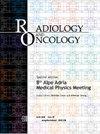心肌灌注闪烁成像中的膈下活动相关伪影。
IF 2.2
4区 医学
Q3 ONCOLOGY
引用次数: 0
摘要
背景单光子发射计算机断层扫描心肌灌注成像(MPI)是一种成熟的评估心肌缺血的无创技术。这种方法通过静脉注射放射性药物,药物在心肌中的累积量与区域血流量成正比。然而,图像质量和诊断准确性可能会受到各种技术和患者相关因素的影响,包括腹部器官(如胃、肠、肝脏和胆囊)对放射性药物的高非特异性摄取,从而导致膈下伪影。这些伪影在评估下壁灌注时尤为棘手,往往需要重复成像,这就降低了伽马相机的可用性,延长了成像时间。结论尽管研究了许多技术来减少胃肠道活动的干扰,但结果并不一致,目前的 MPI 指南也很少提供有关缓解这一问题的有效程序的信息。根据我们的经验,减少伪影的一些可行方法包括:在可能的情况下选择运动负荷试验、延迟成像、摄入液体以及在成像前立即饮用碳酸水。本文章由计算机程序翻译,如有差异,请以英文原文为准。
Subdiaphragmatic activity-related artifacts in myocardial perfusion scintigraphy.
BACKGROUND
Myocardial perfusion imaging (MPI) with single photon emission computed tomography is an established non-invasive technique for assessing myocardial ischemia. This method involves the intravenous administration of a radiopharmaceutical that accumulates in the heart muscle proportional to regional blood flow. However, image quality and diagnostic accuracy can be compromised by various technical and patient-related factors, including high non-specific radiopharmaceutical uptake in abdominal organs such as the stomach, intestines, liver, and gall-bladder, leading to subdiaphragmatic artifacts. These artifacts are particularly problematic for evaluating inferior wall perfusion and often necessitate repeated imaging, which decreases gamma camera availability and prolongs imaging times.
CONCLUSIONS
Despite numerous investigated techniques to reduce interfering gastrointestinal activity, results have been inconsistent, and current MPI guidelines provide scant information on effective procedures to mitigate this issue. Based on our experience, some possible approaches to reducing artifacts include choosing stress testing with an exercise stress test, when possible, late imaging, fluid intake, and consuming carbonated water immediately before imaging.
求助全文
通过发布文献求助,成功后即可免费获取论文全文。
去求助
来源期刊

Radiology and Oncology
ONCOLOGY-RADIOLOGY, NUCLEAR MEDICINE & MEDICAL IMAGING
CiteScore
4.40
自引率
0.00%
发文量
42
审稿时长
>12 weeks
期刊介绍:
Radiology and Oncology is a multidisciplinary journal devoted to the publishing original and high quality scientific papers and review articles, pertinent to diagnostic and interventional radiology, computerized tomography, magnetic resonance, ultrasound, nuclear medicine, radiotherapy, clinical and experimental oncology, radiobiology, medical physics and radiation protection. Therefore, the scope of the journal is to cover beside radiology the diagnostic and therapeutic aspects in oncology, which distinguishes it from other journals in the field.
 求助内容:
求助内容: 应助结果提醒方式:
应助结果提醒方式:


